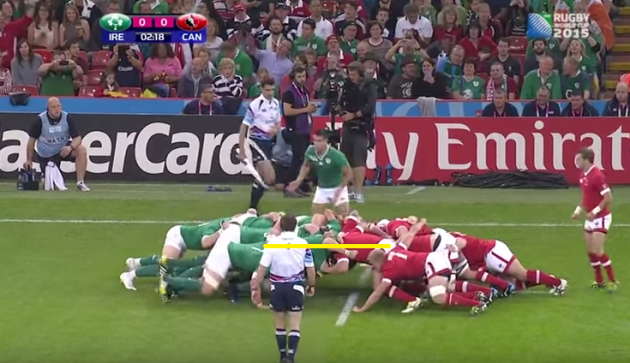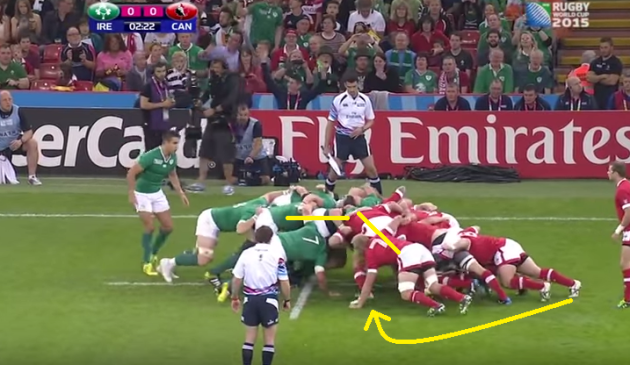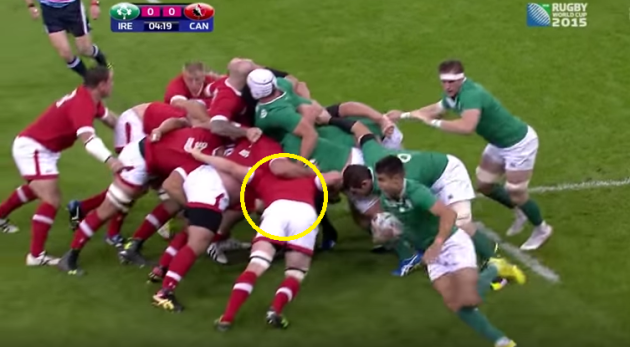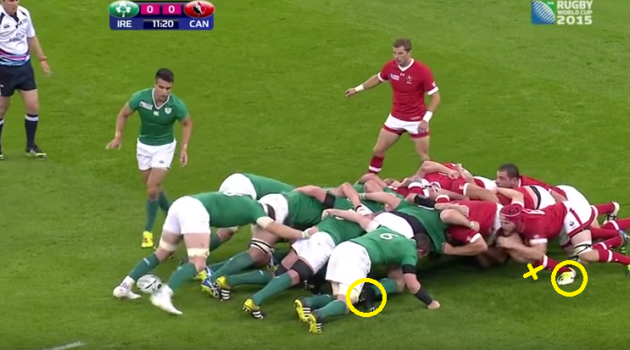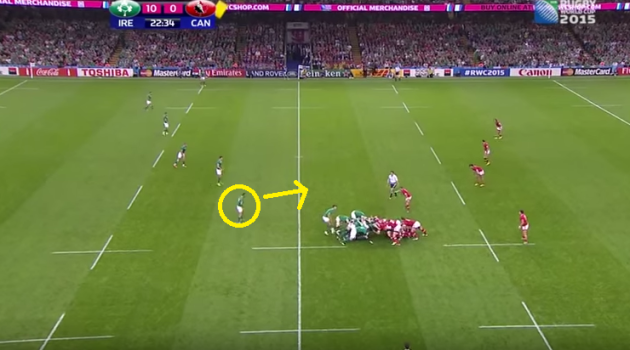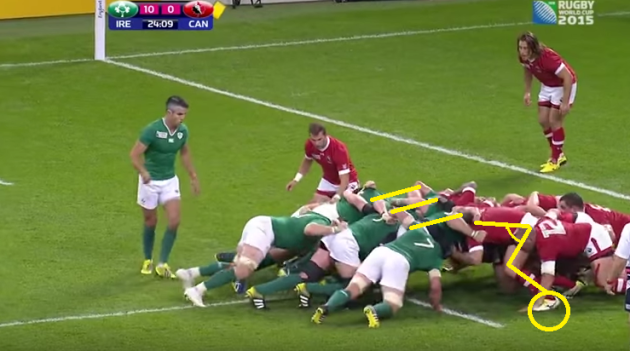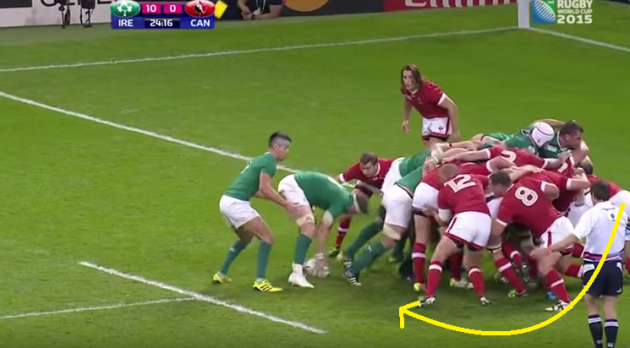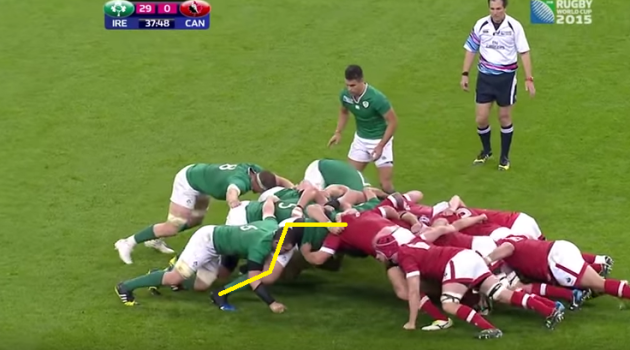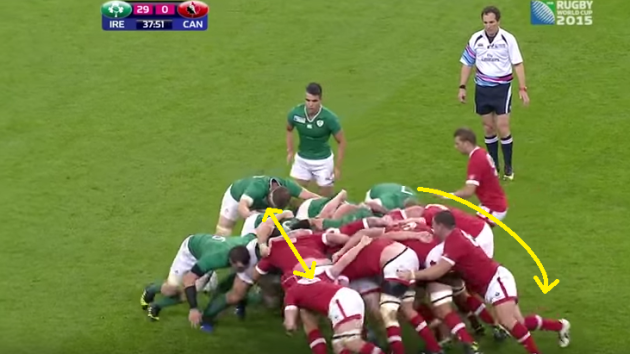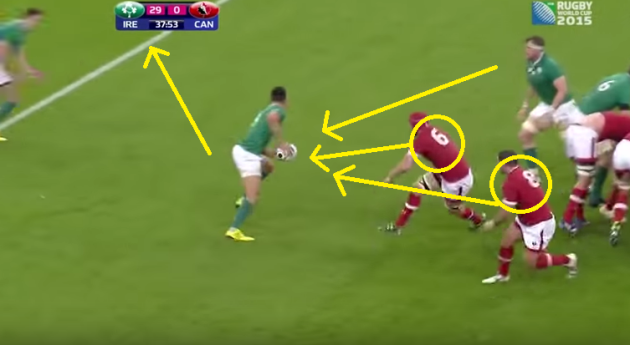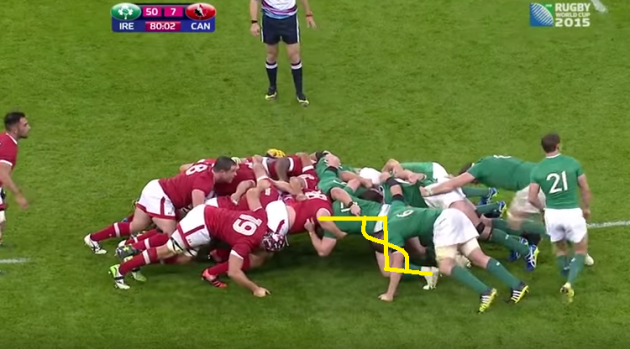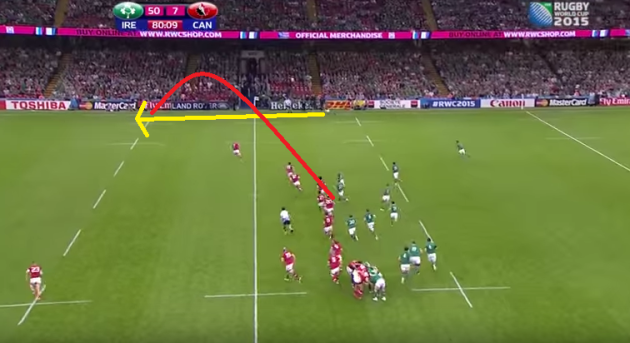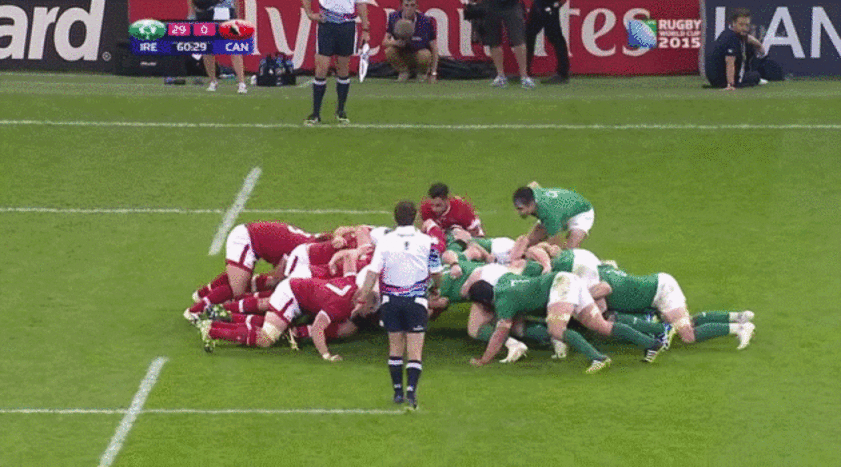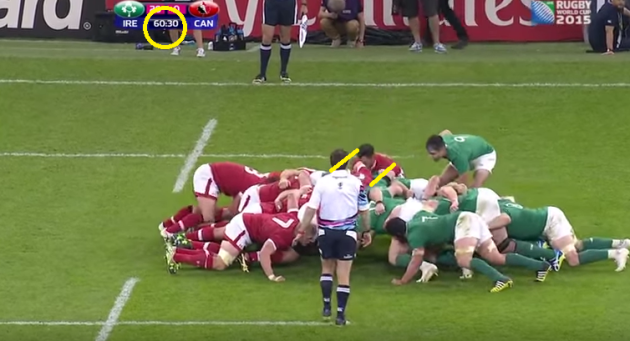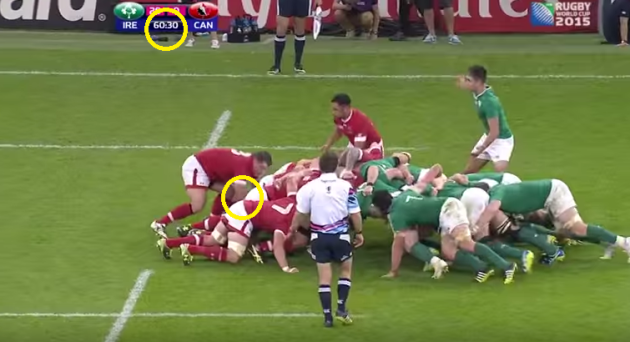THERE WAS A novelty in Cardiff on Saturday.
Of the 12 scrums in total between Ireland and Canada, not one resulted in a penalty or a free-kick from referee Glen Jackson during the 80 minutes. Twice Ireland were awarded advantages but used it to gain yards in attack, and while Jackson could have penalised both sides for their feeding to the scrum, there weren’t a lot of old-fashioned tricks going on between the front rows.
For once, they made it easy for him.
While the gulf in class between the sides was like a canyon, the way each side treated the scrum was fascinating. Instead of trying to butcher the Canadian set-piece, Ireland used their put-in as a platform for backline moves, and almost exclusively sent the ball outside.
Ireland rarely drove Canada back, but it didn’t seem to be the plan. On very few scrums did their front rows make any attempt to milk penalties, rather holding their possession and giving clean ball to the backline.
On the first scrum of the day though, Ireland did show dominance. We’ll look at how they set up below for perspective, with Mike Ross and Canada’s loosehead Hubert Buydens straight and square to one another.
But once Mike Ross starts to move, Buydens tries to whip the scrum, turning perpendicular to Ross and driving inwards.
We can see that Ross is still pointing forwards, while Buydens is almost at a right angle to him, and the backrow are whipping the scrum around.
It’s at this stage that Jerome Garces gives advantage to Ireland, and Conor Murray uses it as an opportunity to break.
With Canada’s scrumhalf Gordon McRorie anticipating Murray would go to the openside, the Munster man is clear down the line before McRorie even notices.
What made things even easier for Murray was Canada’s blindside flanker Kyle Gilmour, was too concerned with driving in on Ireland’s front row, rather than protecting the space.
But from here, the trend with Ireland’s scrums seemed to follow a less-is-more approach.
On their next put-in, Mike Ross barely made any attempt to drive forward, keeping his footwork exactly as it is on the still below.
Even with Ross barley making any push, Buydens had a remarkably wide stance to deal with it, with the X marking the spot where you would usually stand; feet shoulder’s width apart. He’s also planting his foot into the ground, which isn’t advisable as it’s much harder to push off than the front-studs only approach of Ross.
From this scrum, Murray fed Luke Fitzgerald through the middle and he claimed 10 metres or so, but on the next scrum, the gain was even greater from the backline.
Even with Jamie Cudmore in the bin and a centre at blindside, Ireland held back, with Ross again barely making any attempt to wrestle an extra few yards from Hubert Buydens, maintaining the perfect 90 and 120 degreee bends at the hips and knees.
This time, Murray uses Dave Kearney coming in off the wing to start a back move, which ultimately ends with Keith Earls entering the Canadian 22 less than 10 seconds later. They gained more than 30 metres here, and all from holding back slightly.
That break resulted in Paul O’Connell being held up over the line, and with Ireland so close to the try-live, they stepped up the pressure on the Canada front row.
Jack McGrath and Mike Ross both played their part, but Hubert Buydens’ technique will come into question. We can see here how he has his legs quite bunched up, with the angle at his hips far too acute, lowering his ability to push off from his legs.
Again, his feet are planted fully in the ground.
Jack McGrath gets a strong drive up the blindside, and just like on the first scrum of the day, Canada tried to wheel around to try con Garces, who gave Ireland advantage. They didbn’t need the penalty, Iain Henderson barging over the line for a try two phases later.
When their put-in was deeper down the pitch, it was almost exclusively used as an opportunity to experiment with training ground moves.
In this scrum, once again we can see how Ireland took the Canadian backrow out of commission with a clever move.
As usual, Mike Ross is anchoring, and making little attempt to push off his legs; just holding fort.
Jack McGrath then makes a slight nudge up the open side, to leave Canada’s backrow at a disadvantage.
In this instance, Murray moves to the right and is offloaded the ball by Heaslip. This draws both Canada’s openside flanker and number 8 to him.
But as soon as he gets the ball he turns and passes in the opposite direction to Johnny Sexton, who sends Ireland moving down the left, instantly taking two of Canada’s backrow out of the game.
In the second last scrum of the day on 80 minutes, Ireland again held back, and it allowed them get from their own 40m line to the Canadian 5m line in 10 seconds.
With Cian Healy on at loosehead, he was comfortable, and just like in the first half, made very little attempt to cause havoc.
(It is worth noting his angles though, with the angle at his knees virtually 90 degrees. While this isn’t strictly illegal, if the scrum were to slip he could well be penalised for having his feet too far back from his body. It’s one of those calls that’s open to interpretation from the referee. However, if he’s able to scrum that low to the ground and NOT collapse, it’s sensational.)
Again, the move looks rehearsed, with Ian Madigan kicking crossfield to Dave Kearney, who is absolutely hugging the touchline. Kearney catches it 10 metres inside the Canadian half and makes it to within five metres from the goal. Yet again, huge gains as a result of using the scrum as a platform for possession.
In and Out
When Canada had the put-in to a scrum, I don’t think I’ve ever seen a team so eager to get the ball in and out as fast as possible.
From the moment the ball was fed until the moment it came out of the scrum, not one of their four scrums lasted more than one second, which shows just how reluctant they were to engage Ireland in a scrum battle.
The problem with the speed at which they got the ball in and out is that at times, it doesn’t look physically possible to do with a legal feed.
While all of their four scrums were remarkably fast, their final one was the most notable, with the ball going in and out quickly, it’s almost like scrum-half Phil Mack handed the ball to Aaron Carpenter.
If we look at the clock in the top left corner, it reads 60:30 when Mack is releasing the ball into the scrum, while the direction his shoulder are pointing says a lot about the feed.
And when Carpenter has picked the ball and is about to break from the back, the clock is still at 60:30. In and out of the scrum in less than a second!
You would imagine Ireland aren’t going to lose much sleep over this though, they’ve fed enough scrums crooked themselves (as well as everybody else) down the years to take it on the chin.
And on a lighter note, even when you’re feeding it crooked, it’s actually still pretty impressive to be able to get the ball in and out that quickly.
On Sunday, things will be much more different at scrum time though, with the Romanians using it as a weapon to engineer penalties.
If anything, it could be Ireland looking to get it in and out as fast as possible.
